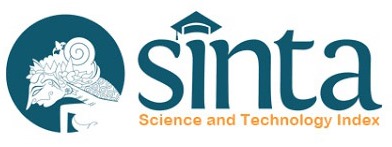Probabilistic Health Risk Assessment Due to Natural Formaldehyde Intake Through Opah Fish (Lampris Guttatus) Consumption in Indonesia
Abstract
Keywords
Full Text:
PDFReferences
Abdollahi, M., & Hosseini, A. (2014). Formaldehyde. Encyclopedia of Toxicology, 2, 653–656. http://doi.org/10.1016/B978-0-12-386454-3.00388-2
Aminah, S. A., Zailina, H., & Fatimah, A. B. (2013). Health Risk Assessment of Adults Consuming Commercial Fish Contaminated with Formaldehyde. Food and Public Health. http://doi.org/10.5923/j.fph.20130301.06
Anonymous. (2016a). 14 TON IKAN BERFORMALIN DIMUSNAHKAN. Retrieved May 1, 2018, from http://utara.jakarta.go.id/srv4/detail/14-Ton-Ikan-Berformalin-Dimusnahkan
Anonymous. (2016b). Lima Ton Ikan Semar Opah Berformalin Dikibur. Retrieved May 1, 2018, from http://wartakota.tribunnews.com/2016/06/17/lima-ton-ikan-semar-opah-berformalin-dikibur
Anonymous. (2016c). Sebanyak 14 Ton Ikan Semar Opah Berformalin Dimusnahkan. Retrieved from http://wartakota.tribunnews.com/2016/09/30/sebanyak-14-ton-ikan-semar-opah-berformalin-dimusnahkan
Benjakul, S., Visessanguan, W., & Tanaka, M. (2004). Induced formation of dimethylamine and formaldehyde by lizardfish (Saurida micropectoralis) kidney trimethylamine-N-oxide demethylase. Food Chemistry, 84(2), 297–305. http://doi.org/10.1016/S0308-8146(03)00214-0
Bhowmik, S., Begum, M., Hossain, M. A., Rahman, M., & Alam, A. K. M. N. (2017). Determination of formaldehyde in wet marketed fish by HPLC analysis: A negligible concern for fish and food safety in Bangladesh. Egyptian Journal of Aquatic Research, 43(3), 245–248. http://doi.org/10.1016/j.ejar.2017.08.001
Bianchi, F., Careri, M., Musci, M., & Mangia, a. (2007). Fish and food safety: Determination of formaldehyde in 12 fish species by SPME extraction and GC–MS analysis. Food Chemistry, 100(3), 1049–1053. http://doi.org/10.1016/j.foodchem.2005.09.089
BKIPM. (2017). Prosentase Distribusi Moonfish Ekspor & Domestik. Retrieved December 12, 2017, from www.bkipm.kkp.go.id
BKIPM. (2018). Data Lalu Lintas Ikan 2015 -2017. Retrieved February 2, 2018, from www.bkipm.kkp.go.id
EFSA. (2014). Endogenous formaldehyde turnover in humans compared with exogenous contribution from food sources. EFSA Journal, 12(2), 3550. http://doi.org/10.2903/j.efsa.2014.3550
Hoque, M. d. S., Jacxsens, L., Rahman, M. d. B., Nowsad, A. A. K. M., Azad, S. M. O., De Meulenaer, B., … Rahman, M. (2018). Evaluation of artificially contaminated fish with formaldehyde under laboratory conditions and exposure assessment in freshwater fish in Southern Bangladesh. Chemosphere, 195(2018), 702–712. http://doi.org/10.1016/j.chemosphere.2017.12.111
Hoque, M. S., Jacxsens, L., De Meulenaer, B., & Alam, A. K. M. N. (2016). Quantitative Risk Assessment for Formalin Treatment in Fish Preservation: Food Safety Concern in Local Market of Bangladesh. Procedia Food Science, 6(Icsusl 2015), 151–158. http://doi.org/10.1016/j.profoo.2016.02.037
IARC. (2012). Chemical agents and related occupations. IARC Monographs on the Evaluation of Carcinogenic Risks to Humans / World Health Organization, International Agency for Research on Cancer, 100(Pt F), 9–562. http://doi.org/now it’s officially a carcinogen...
Muljati, S., Triwinarto, A., Utami, N., Penelitian, P., & Hermina. (2016). GAMBARAN MEDIAN TINGGI BADAN DAN BERAT BADAN MENURUT KELOMPOK UMUR PADA PENDUDUK INDONESIA YANG SEHAT BERDASARKAN HASIL RISKESDAS 2013 (DESCRIPTION OF MEDIAN NUMBER OF WEIGHT AND HEIGHT CLASSIFIED BY AGE GROUP ON HEALTHY INDONESIAN CITIZENS BASED ON RISKE. Penelitian Gizi Dan Makanan, 39(2), 137–144.
Mundt, K. A., Gentry, P. R., Dell, L. D., Rodricks, J. V., & Boffetta, P. (2018). Six years after the NRC review of EPA’s Draft IRIS Toxicological Review of Formaldehyde: Regulatory implications of new science in evaluating formaldehyde leukemogenicity. Regulatory Toxicology and Pharmacology, 92(October 2017), 472–490. http://doi.org/10.1016/j.yrtph.2017.11.006
Murtini, J. T., Ariyani, F., Januar, H. I., Barokah, G. R., Putri, A. K., Annisah, U., … Wibowo, S. (2017). PB FORMALDEHID ALAMI OPAH - FINAL. Jakarta.
Murtini, J. T., Riyanto, R., Priyanto, N., & Hermana, I. (2014). Natural Development of Formaldehyde on Some Kinds of Marine Fish during Storage in Crushed Ice. JPB Perikanan, 9, 143–151.
Murtini, J. T., Wibowo, S., Ariyani, F., Putri, A. K., Barokah, G. R., Hermana, I., … Andayani, F. (2017). LAPORAN TEKNIS PENELITIAN TA. 2017, POLICY BRIEF KANDUNGAN FORMALDEHID ALAMI PADA IKAN OPAH (Lampris guttatus). Jakarta.
Nash, T. (1953). The colorimetric estimation of formaldehyde by means of the Hantzsch reaction. Biochemical Journal, 55(3), 416–421. http://doi.org/10.1042/bj0550416
Norliana, S., Abdulamir, A. S., Bakar, F. A., & Salleh, A. B. (2009). The Health Risk of Formaldehyde to Human Beings. American Journal of Pharmacology and Toxicology, 4(3), 98–106.
Palisade. (2010). @RISK: Risk Analysis using Monte Carlo Simulation in Excel and Project - Palisade – Palisade. Retrieved from https://www.palisade.com/risk/default.asp#versions
Rachmawati, N., Riyanto, R., & Ariyani, F. (2007). Pembentukan Formaldehid Pada ikan Kerapu Macan (Ephinephelus fuscoguttatus) Selama Penyimpanan Suhu Dingin. Jurnal Pascapanen Dan Bioteknologi Dan Bioteknologi Kelautan Dan Perikanan, 2(2), 137–145.
Rohmad, G., Putri, A. K., Anissah, U., & Murtini, T. (2018). Formation of Natural Formaldehyde and Deterioration of Cantik Grouper Fish (Epinephelus fuscoguttatus × E. microdon) During Frozen Storage. Jurnal Pascapanen Dan Bioteknologi Dan Bioteknologi Kelautan Dan Perikanan, 13(1), 1–8. http://doi.org/http://dx.doi.org/10.15578/jpbkp.v13i1
Siswanto, dkk. (2014). Buku Studi Diet Total : Survei Konsumsi Makanan Individu Indonesia 2014. (Trihono, Atmarita, A. B. Jahari, & D. Kartono, Eds.) (1st ed.). Jakarta: Lembaga Penerbitan Badan Litbangkes.
Tang, X., Bai, Y., Duong, A., Smith, M. T., Li, L., & Zhang, L. (2009). Formaldehyde in China: production, consumption, exposure levels, and health effects. Environment International, 35(8), 1210–24. http://doi.org/10.1016/j.envint.2009.06.002
Wang, S., Cui, X., & Fang, G. (2007). Rapid determination of formaldehyde and sulfur dioxide in food products and Chinese herbals. Food Chemistry, 103(4), 1487–1493. http://doi.org/10.1016/j.foodchem.2006.09.023
Yeh, T.-S., Lin, T.-C., Chen, C.-C., & Wen, H.-M. (2013). Analysis of free and bound formaldehyde in squid and squid products by gas chromatography-mass spectrometry. Journal of Food and Drug Analysis, 21(2), 190–197. http://doi.org/10.1016/j.jfda.2013.05.010
DOI: https://doi.org/10.15578/squalen.354
Article Metrics
 PDF Download: 341
PDF Download: 341
Refbacks
- There are currently no refbacks.
ISSN : 2089-5690(print), E-ISSN : 2406-9272(online)
This work is licensed under a Creative Commons Attribution-NonCommercial-ShareAlike 4.0 International License.








